Guangfeng District
Guangfeng District (simplified Chinese: 广丰区; traditional Chinese: 廣豐區; pinyin: Guǎngfēng Qū; lit.: 'Wide and luxuriant') is a district of the city of Shangrao, located in northeastern Jiangxi province, eastern China.
Guangfeng 广丰区 Kwangfeng | |
|---|---|
District | |
Juntan Reservoir | |
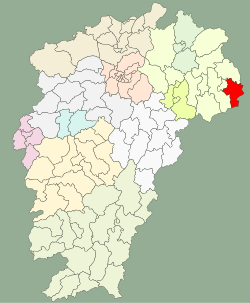 Location in Jiangxi | |
| Coordinates: 28°26′18″N 118°10′46″E | |
| Country | People's Republic of China |
| Province | Jiangxi |
| Prefecture-level city | Shangrao |
| Capital | Yongfeng |
| Area | |
| • Total | 1,377.79 km2 (531.97 sq mi) |
| Population | |
| • Total | 760,000 |
| • Density | 550/km2 (1,400/sq mi) |
| Time zone | UTC+8 (China Standard) |
| Postal code | 334600 |
| Area Code | 0793 |
| Vehicle registration | 赣E |
| Website | www |
The easternmost county-level division of Jiangxi, Guangfeng borders Zhejiang and Fujian provinces. It covers 1,377.79 km2 (531.97 sq mi).
The population is 760,000 people.
History
The district was first established during the Tang dynasty in 758 as a county, then repealed in 812. In 1074, during the Song dynasty, the district was reestablished as a county.
Administration
Guangfeng has been a county for over 1,300 years. Administratively, the district is part of the prefecture-level city of Shangrao. The county administers 23 townships.
Climate
The climate is temperate, with abundant rainfall during the monsoon season. It has clearly differentiated summers and winters.
Economy
Guangfeng was once a poor district, but now it is one of the wealthiest counties of Jiangxi. The most famous industry of the district is the tobacco industry. The GDP of 2005 is 7.29 billion.
Features
Guangfeng's most famous feature is Boshan Temple, which lies in the west of the county. The Buddhist temple has a history over 1000 years. Xin Qiji, the famous poet of the South Song dynasty, visited it often.
Sheshantou Site, in Guangfeng District, is an important Neolithic archaeological site of Jiangxi Province.[1]
References
- Wan Z, Yang X, Quansheng G E, et al. Plant Resource Utilization at Sheshantou Site in Jiangxi Province Based on Starch Grain Analysis[J]. Progress in Geography, 2012.
Gallery
| Wikimedia Commons has media related to Guangfeng District. |
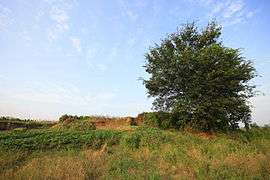 Sheshantou Site
Sheshantou Site- Liushiyan Hill
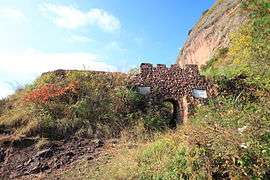 Jiuxianshan Castle
Jiuxianshan Castle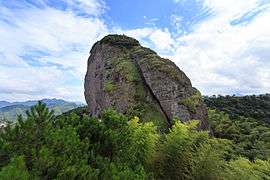 Baihuayan Hill
Baihuayan Hill- Yushi Hill
- Songfeng Temple
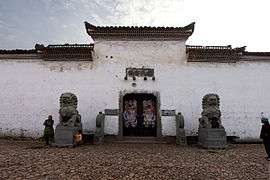 Zhu's ancestral hall in Longxi
Zhu's ancestral hall in Longxi